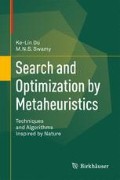Abstract
EAs and PSO tend to converge to a single optimum and hence progressively lose diversity. This is not the case for artificial immune systems (AISs). AISs are based on four main immunological theories, namely, clonal selection, immune networks, negative selection, and danger theory. This chapter introduces four immune algorithms inspired by the four immunological theories.
Access this chapter
Tax calculation will be finalised at checkout
Purchases are for personal use only
References
Ada GL, Nossal GJV. The clonal selection theory. Sci Am. 1987;257(2):50–7.
Atlan H, Cohen IR. Theories of immune networks. Berlin: Spriner; 1989.
Burnet FM. The clonal selection theory of acquired immunity. Cambridge, UK: Cambridge University Press; 1959.
Coelho GP, Von Zuben FJ. Omni-aiNet: an immune-inspired approach for omni optimization. In: Proceedings of the 5th international conference on artificial immune systems, Oeiras, Portugal, Sept 2006. p. 294–308.
Cutello V, Nicosia G, Pavone M. An immune algorithm with stochastic aging and Kullback entropy for the chromatic number problem. J Combinator Optim. 2007;14(1):9–33.
Dasgupta D. Advances in artificial immune systems. IEEE Comput Intell Mag. 2006;1(4):40–9.
de Castro PAD, Von Zuben FJ. BAIS: a Bayesian artificial immune system for the effective handling of building blocks. Inf Sci. 2009;179(10):1426–40.
de Castro LN, Timmins J. An artificial immune network for multimodal function optimization. In: Proceedings of IEEE congress on evolutionary computation, Honolulu, HI, USA, May 2002, vol. 1, p. 699–704.
de Castro LN, Von Zuben FJ. aiNet: an artificial immune network for data analysis. In: Abbass HA, Sarker RA, Newton CS, editors. Data mining: a heuristic approach. Hershey, USA: Idea Group Publishing; 2001. p. 231–259.
de Castro LN, Von Zuben FJ. Learning and optimization using the clonal selection principle. IEEE Trans Evol Comput. 2002;6(3):239–51.
de Franca FO, Von Zuben FJ, de Castro LN. An artificial immune network for multimodal function optimization on dynamic environments. In: Proceedings of genetic and evolutionary computation conference (GECCO), Washington, DC, USA, June 2005. p. 289–296.
Engelbrecht AP. Computational intelligence: an introduction. New York: Wiley; 2007.
Ferreira C. Gene expression programming: a new adaptive algorithm for solving problems. Complex Syst. 2001;13(2):87–129.
Forrest S, Perelson AS, Allen L, Cherukuri R. Self-nonself discrimination in a computer. In: Proceedings of IEEE symposium on security and privacy, Oakland, CA, USA, May 1994. p. 202–212.
Forrest S, Hofmeyr SA, Somayaji A. Computer immunology. Commun ACM. 1997;40(10):88–96.
Garret SM. Parameter-free, adaptive clonal selection. In: Proceedings of IEEE congress on evolutionary computation (CEC), Portland, OR, June 2004. p. 1052–1058.
Greensmith J, Aickelin U. Dendritic cells for SYN scan detection. In: Proceedings of genetic and evolutionary computation conference (GECCO), London, UK, July 2007. p. 49–56.
Greensmith J, Aickelin U. The deterministic dendritic cell algorithm. In: Proceedings of the 7th International conference on artificial immune systems (ICARIS), Phuket, Thailand, August 2008. p. 291–303.
Greensmith J, Aickelin U, Cayzer S. Introducing dendritic cells as a novel immune-inspired algorithm for anomaly detection. In: Proceedings of the 4th international conference on artificial immune systems (ICARIS), Banff, Alberta, Canada, Aug 2005. p. 153–167.
Hofmeyr SA, Forrest S. Architecture for an artificial immune system. Evol Comput. 2000;8(4):443–73.
Jerne NK. Towards a network theory of the immune system. Annales d’Immunologie (Paris). 1974;125C:373–89.
Jiao L, Wang L. A novel genetic algorithm based on immunity. IEEE Trans Syst Man Cybern Part A. 2000;30(5):552–61.
Matzinger P. Tolerance, danger and the extended family. Annu Rev Immunol. 1994;12:991–1045.
Matzinger P. The danger model: a renewed sense of self. Science. 2002;296(5566):301–5.
Owens NDL, Greensted A, Timmis J, Tyrrell A. T cell receptor signalling inspired kernel density estimation and anomaly detection. In: Proceedings of the 8th international conference on artificial immune systems (ICARIS), York, UK, Aug 2009. p. 122–135.
Perelson AS. Immune network theory. Immunol Rev. 1989;110:5–36.
Smith RE, Forrest S, Perelson AS. Population diversity in an immune system model: implications for genetic search. In: Whitley LD, editor. Foundations of genetic algorithms, vol. 2. San Mateo, CA: Morgan Kaufmann Publishers; 1993. p. 153–165.
Tang T, Qiu J. An improved multimodal artificial immune algorithm and its convergence analysis. In: Proceedings of world congress on intelligent control and automation, Dalian, China, June 2006. p. 3335–3339.
Varela F, Sanchez-Leighton V, Coutinho A. Adaptive strategies gleaned from immune networks: Viability theory and comparison with classifier systems. In: Goodwin B, Saunders PT, editors. Theoretical biology: epigenetic and evolutionary order (a Waddington Memorial Conference). Edinburgh, UK: Edinburgh University Press; 1989. p. 112–123.
Woldemariam KM, Yen GG. Vaccine-enhanced artificial immune system for multimodal function optimization. IEEE Trans Syst Man Cybern Part B. 2010;40(1):218–28.
Xu X, Zhang J. An improved immune evolutionary algorithm for multimodal function optimization. In: Proceedings of the 6th international conference on natural computing, Haikou, China, Aug 2007. p. 641–646.
Zhang R, Li T, Xiao X, Shi Y. A danger-theory-based immune network optimization algorithm. Sci World J;2013:Article ID 810320, 13 p.
Author information
Authors and Affiliations
Corresponding author
Rights and permissions
Copyright information
© 2016 Springer International Publishing Switzerland
About this chapter
Cite this chapter
Du, KL., Swamy, M.N.S. (2016). Artificial Immune Systems. In: Search and Optimization by Metaheuristics. Birkhäuser, Cham. https://doi.org/10.1007/978-3-319-41192-7_10
Download citation
DOI: https://doi.org/10.1007/978-3-319-41192-7_10
Published:
Publisher Name: Birkhäuser, Cham
Print ISBN: 978-3-319-41191-0
Online ISBN: 978-3-319-41192-7
eBook Packages: Mathematics and StatisticsMathematics and Statistics (R0)

